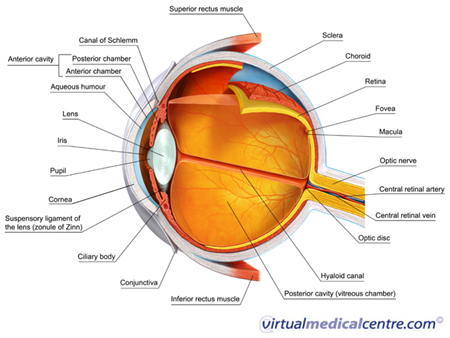Introduction to eye health and nutrition
The eyes, like all other organs of the body, depend upon nutrients, vitamins and minerals, to maintain their health and proper function. Thus, the way an individual eats affects the health of their eyes.
Many eye diseases and disorders cannot be cured once they begin to develop. Eye diseases also impact significantly on an individual’s quality of life, so preventing these conditions is particularly important.
Many individuals are not aware that their nutritional habits affect the health of their eyes, and as such, may not know what they should be eating to protect their eyesight. This page provides an overview of the eye disorders which are associated with poor eating habits, and the nutritional measures an individual can take to prevent eye disorders.
Eye diseases associated with poor nutrition
Diabetic eye disease is a group of eye conditions which arise frequently in diabetics because of changes to the small blood vessels in the eye caused by diabetes.
Diabetic proliferative retinopathy is a condition where changes to the blood vessel system of the eye’s retina cause some blood vessels to burst and others to become blocked and thus affect blood flow to the retina. This condition threatens the sight of some 60% of diabetics who have lived with diabetes for 20 years or longer and, in the past, has caused blindness in some 5% of diabetics after 30 years. Blindness results in about 50% of cases of proliferative retinopathy if the condition is left untreated.
Diabetic retinopathy can also lead to diabetic maculopathy, a condition which begins when fluid accumulates in the eye’s macula tissues. Diabetic maculopathy can cause blindness if left untreated.
Diabetics also have a higher risk of developing cataracts earlier in life.
As many cases of type 2 diabetes are induced by poor eating habits, many cases of diabetic eye disease are also related, at least in part, to poor nutrition.
Night blindness is a condition characterised by degenerating night vision which can, in serious cases, lead to total blindness. It is associated with inadequate intake of Vitamin A (found in spinach, carrots and other vegetables) and is most common amongst pregnant women and preschool aged children in developing countries.
Deficiency in Vitamin A is the leading cause of preventable blindness in children in developing countries.
Also known as keroconjunctivitis sicca, dry eye disease is a condition characterised by inadequate tear production. A lack of tears can cause eye irritation, and, in the long term may cause damage to the eye’s surface.
Individuals with diets low in omega-3 fatty acids and Vitamin A are more likely to develop dry eye disease. Individuals who suffer from diabetes, a condition often linked to nutritional factors, are also at an increased risk for the disease.
Cataract is a condition characterised by the lens of the eye becoming increasingly opaque, which can lead to impaired eyesight or blindness. The risk of developing cataract, or of cataract disease progressing rapidly, is associated with a number of nutritional factors, most particularly antioxidant intake.
Antioxidants are micronutrients found in many fruits and vegetables and include Vitamin A and C and lutein. One large study of nutrition and vision reported that individuals who used Vitamin C supplements for more than 10 years were 60% less likely to develop cortical cataract than individuals who did not use Vitamin C supplements. Good sources of Vitamin C include citrus fruits, tomatoes, strawberries and broccoli.
A second study also reported that a high intake of Vitamins C and E protected against cataract for individuals who were at high risk of developing them. Vitamin E can be obtained by eating leafy green vegetables and nuts.
Another large study reported a high intake lutein-zeaxanthin reduced the likelihood of developing nuclear cataract. The best source of lutein and zeaxanthin are leafy green vegetables such as spinach.
 |
For more information, see Cataracts. |
Age-related macular degeneration
Age-related macular degeneration is a condition in which visual acuity deteriorates and progresses as the individual ages, and is the most prominent cause of age-related blindness in Australia.
There is evidence from studies and trials that a number of dietary factors influence the progression of age-related macular degeneration, though some of the evidence is inconsistent so further research is warranted:
- Omega-3 fatty acids:Omega-3 fatty acids are found in high concentrations in some cells within the eye, andare thought to regulate cell survival and inflammatory processes. Several studies have reported a lower risk of macular degeneration in individuals with a high intake of omega-3 fatty acids and fish, as fish is a major dietary source of omega-3 fatty acids.One study has shown that eating fish at least three times per week could reduce the risk of advanced age-related macular degeneration.
- Dietary fat: Several studies have looked at dietary intake of specific types of fat and the possible link with macular degeneration. One eye disease study based in the US showed that an increased intake of several types of fat, including vegetable fats, monounsaturated fats and polyunsaturated fats, may be associated with an increased risk of developing advanced age-related macular degeneration.
- Glycaemic index: One study reported that non-diabetic people with a higher glycaemic index were at an increased likelihood of having more severe age-related macular degeneration.
- Dietary antioxidants: Results from studies that have explored the link between dietary antioxidants and macular degeneration have revealed inconsistent associations. Antioxidants include beta-carotene (found in carrots, pumpkin, sweet potato, spinach), vitamin C(found in berries, oranges, broccoli, parsley)and vitamin E(found in asparagus, avocado, nuts, egg). In one study, elderly individuals who had a high intake of beta-carotene, vitamin C and vitamin E were shown to have less risk of age-related macular degeneration. However, other studies have reported that there is currently insufficient evidence to support the role of antioxidants for preventing this condition further research is needed..
- Dietary lutein and zeaxanthin intake: Lutein and zeaxanthin are carotenoid compounds found in leafy green vegetables. Some studies have found individuals who have high intakes of lutein and zeaxanthin have a decreased risk of macular degeneration, while other studies have shown no such effect.
 |
For more information, see Macular Degeneration. |
Glaucoma is a range of eye diseases which cause damage to the optic nerve. The optic nerve transmits images from the eye’s retina to the brain. Damage to the optic nerve is irreversible and blindness results once the entire nerve becomes damaged.
Glaucoma eye diseases are the leading cause of blindness globally and one of the leading causes of blindness in Australia, following cataract.
There is some evidence which shows that diabetic individuals are more likely to develop glaucoma than non diabetic individuals. As diabetes is often induced by poor eating habits, poor nutrition may be an indirect factor contributing to the increased risk of glaucoma amongst diabetics. The Blue Mountains Eye Study, a large study of eye disorders in the elderly in Australia, reported that diabetic patients were twice as likely to develop glaucoma compared to non-diabetic individuals.
 |
For more information, see Glaucoma. |
Protecting the eyes through good nutritional practices
There are a range of nutritional measures which individuals can take to reduce the risk of eye diseases and disorders associated with nutritional factors.
Preventing and controlling diabetes
As diabetic eye disease is a common outcome amongst diabetic patients, preventing diabetes also helps to protect the eyes from diabetic and other associated eye diseases. The key measures an individual can take to reduce their risk of diabetes are nutritional, and include reducing fat intake, increasing fibre intake and reducing weight (for individuals with a BMI > 25).
A Mediterranean style diet has been shown to protect against the metabolic abnormalities which characterise diabetes.
For individuals who already have diabetes, the progression of diabetic eye disease can be controlled by managing the metabolic symptoms (e.g. high blood pressure) of diabetes (see reducing blood pressure and improving glycaemia below).
This information will be collected for educational purposes, however it will remain anonymous.
Screening diabetic patients for eye disease
As diabetic eye diseases are treated most effectively when they are asymptomatic, diabetic individuals should ensure that they have regular eye examinations to check for diabetic eye conditions. Regular examination can lead to early detection of diabetic eye diseases and intervention to prevent associated complications (e.g. visual impairment).
There is evidence that reducing blood pressure slows the progression of diabetic eye disease, and thus nutritional interventions to improve blood pressure can prevent complications associated with this disease. Consuming a diet low in saturated fats with a high intake of leafy green vegetables and fibre (e.g. a Mediterranean style diet) can reduce blood pressure.Individuals should also quit smoking to manage their blood pressure.
Improving blood sugar levels (also known as glycaemia) slows the progression of diabetic eye disease, and protects against age related macular degeneration. For example, one study estimated 20% of cases of age-related macular degeneration amongst elderly individuals could be eliminated by reducing glucose intake. A diet low in saturated fats, high in vegetables and fibre such as a Mediterranean style diet has been demonstrated to improve blood sugar levels.
Eating plenty of fresh fruits and vegetables

While antioxidant vitamin supplements are available, individuals should aim to eat at least two servings of fruit and five servings of vegetables each day to ensure they meet the recommended daily intake for antioxidant vitamins.
Taking antioxidant vitamin supplements
Taking antioxidant supplements such as Vitamin C and Vitamin A, can help protect against eye disorders, particularly in pregnant women.
More information
 |
For more information on nutrition, including information on types and composition of food, nutrition and people, conditions related to nutrition, and diets and recipes, as well as some useful videos and tools, see Nutrition. |
References
- Richer S, Newman S.Diet and nutrition [online]. American Optometric Association;2006 [cited 15 May 2009]. Available from URL: http://www.aoa.org/x11813.xml
- Kumar P, Clark M. Clinical Medicine (5th edition). Edinburgh: Elsevier Science Ltd; 2002.
- Bazzano LA, Serdula M, Liu S. Prevention of type 2 diabetes by diet and lifestyle modification. J Am Coll Nutr. 2005; 24(5): 310-9.
- Semba RD, de Pee S, Panagides D, Poly O, Bloem MW. Risk factors for nightblindness among women of childbearing age in Cambodia. Eur J Clin Nutr. 2003; 57(12): 1627-32.
- World Health Organization. Micronutrient deficiencies: Vitamin A deficiency [online]. World Health Organization; 2009 [cited 15 May 2009]. Available from URL: http://www.who.int/nutrition/topics/vad/en/
- Perry HD. Dry eye disease: Pathophysiology, classification, and diagnosis. Am J Manag Care. 2008; 14(3 Suppl): S79-87.
- Lucas R, McMichael T, Smith W, Armstrong B. Solar ultraviolet radiation: Global burden of disease from solar ultraviolet radiation [online]. World Health Organization. 2006 [cited 15 May 2009]. Available from URL: http://www.who.int/uv/publications/solaradgbd/en/index.html
- Taylor A, Jacques PF, Chylack LT Jr, Hankinson SE, Khu PM, Rogers G, et al. Long-term intake of vitamins and carotenoids and odds of early age-related cortical and posterior subcapsular lens opacities. Am J Clin Nutr. 2002; 75(3): 540-9.
- Lyle BJ, Mares-Perlman JA, Klein BE, Klein R, Greger JL. Antioxidant intake and risk of incident age-related nuclear cataracts in the Beaver Dam Eye Study. Am J Epidemiol. 1999; 149(9): 801-9.
- Chiu CJ, Milton RC, Gensler G, Taylor A. Association between dietary glycemic index and age-related macular degeneration in nondiabetic participants in the Age-Related Eye Disease Study. Am J Clin Nutr. 2007; 86(1): 180-8.
- Chong EW, Wong TY, Kreis AJ, Simpson JA, Guymer RH. Dietary antioxidants and primary prevention of age related macular degeneration: Systematic review and meta-analysis. BMJ. 2007; 335(7623): 755.
- National Eye Institute. Glaucoma [online]. National Institutes of Health; 2009 [cited 15 May 2009]. Available from URL: http://www.nei.nih.gov/glaucoma/
- Foran S, Wang JJ, Mitchell P. Causes of incident visual impairment: The Blue Mountains Eye Study. Arch Ophthalmol. 2002; 120(5): 613-9.
- Pelitli Grl V, Esgin H. Risk factors for neovascular glaucoma in cases with central retinal vein occlusion [in Turkish]. J Retina-Vitreous. 2005; 13(1): 39-43.
- Centre for Vision Research. Blue Mountains Eye Study [online]. Centre for Vision Research; 2006 [cited 15 May 2009]. Available from URL: http://www.cvr.org.au/bmes.htm
- Leese GP, Ellis JD. Review: Overview of diabetic eye disease. Br J Diab Vasc Dis.2002; 2(1): 14-7.
- Esposito K, Marfella R, Ciotola M, Di Palo C, Giugliano F, Giugliano G, et al. Effect of a mediterranean-style diet on endothelial dysfunction and markers of vascular inflammation in the metabolic syndrome: A randomized trial. JAMA. 2004; 292(12): 1440-6.
- Go for 2&5 [online]. Australian Government Department of Health and Ageing; 2005 [cited 15 May 2009]. Available from URL: http://www.gofor2and5.com.au/article.aspx?c=1&a=135&n=1
- Coleman HR, Chan CC, Ferris FL 3rd, Chew EY. Age-related macular degeneration. Lancet. 2008; 377(9652): 1835-45.
- Chua B, Flood V, Rochtchina E, Wang JJ, Smith W, Mitchell P. Dietary fatty acids and the 5-year incidence of age-related maculopathy. Arch Ophthalmol. 2006; 124(7): 981-6.
- Seddon JM, Rosner B, Sperduto PD, Yannuzzi L, Haller JA, Blair NP, et al. Dietary fat and risk for advanced age-related macular degeneration. Arch Ophthalmol. 2001; 119(8): 1191-9.
All content and media on the HealthEngine Blog is created and published online for informational purposes only. It is not intended to be a substitute for professional medical advice and should not be relied on as health or personal advice. Always seek the guidance of your doctor or other qualified health professional with any questions you may have regarding your health or a medical condition. Never disregard the advice of a medical professional, or delay in seeking it because of something you have read on this Website. If you think you may have a medical emergency, call your doctor, go to the nearest hospital emergency department, or call the emergency services immediately.








